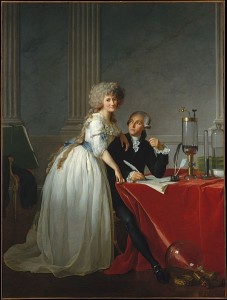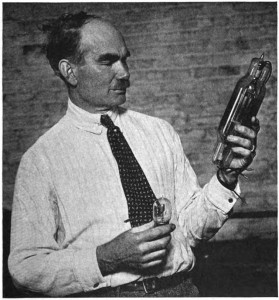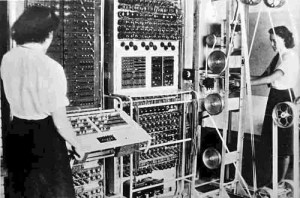SciTech Tuesday: This Day in History–Tubes were everywhere!
In World War II militaries learned to apply old technologies for new purposes. For example, the chemistry of combustion was used in engines and in rockets and bombs, but that technology went back hundreds of years. The science of electronics was newer, but 30 year-0ld inventions became the basis of one of the world’s newest technologies–a powerful, code-breaking computer.
Lavoisier and combustion
 Antoine-Laurent Lavoisier was born on this date in 1743. He was a great experimenter, and early chemist. He was born into a wealthy aristocratic family, and used his capital to purchase into a private company that the French government hired to collect taxes. This made Lavoisier even more wealthy, and he used that money to build and supply a large laboratory. In 1778 he conducted a set of experiments that showed air to be a mixture of two gases. Lavoisier named the gases oxygen and nitrogen. He then showed that oxygen was the gas involved in combustion, overturning the prevailing phlogiston theory. In his studies of combustion Lavoisier established the conservation of mass in chemical reactions. He also systematized the naming of chemical compounds. His wealth and aristocratic heritage helped Lavoisier to build his scientific career, but they and his role in tax collection also led to his death. He met his end at the guillotine in 1794.
Antoine-Laurent Lavoisier was born on this date in 1743. He was a great experimenter, and early chemist. He was born into a wealthy aristocratic family, and used his capital to purchase into a private company that the French government hired to collect taxes. This made Lavoisier even more wealthy, and he used that money to build and supply a large laboratory. In 1778 he conducted a set of experiments that showed air to be a mixture of two gases. Lavoisier named the gases oxygen and nitrogen. He then showed that oxygen was the gas involved in combustion, overturning the prevailing phlogiston theory. In his studies of combustion Lavoisier established the conservation of mass in chemical reactions. He also systematized the naming of chemical compounds. His wealth and aristocratic heritage helped Lavoisier to build his scientific career, but they and his role in tax collection also led to his death. He met his end at the guillotine in 1794.
Combustion is obviously very important in designing many of the weapons used in WWII. The internal combustion engine provided the power for all the tanks and armored vehicles in the war, and the vast majority of the aircraft. Later, rocketry developed but it also used combustion as the primary source of energy. Lavoisier was an empiricist, not overly interested in applications of the work he did. But his investigations helped develop chemistry into a systematic field of study, and his discoveries about conservation of matter and combustion are critical to the last century of technologies.
de Forest and vacuum tubes
Lee de Forest was born in 1873 in Iowa. He was one of the great American inventors in the early 20th century. He called himself the Father of Radio, and said, ‘I discovered an Invisible Empire of the Air, intangible, yet solid as granite.’ de Forest was only overstating his importance by a bit. Edison had invented the lightbulb, and the ‘wireless’ could use radio waves to send signals, but when de Forest developed the Audion vacuum tube in 1906 he provided a major advance in technology. The Audion, the first triode, allowed amplification of signals and thus the real broadcasting of radio. de Forest was a character in the mold of Tesla—bombastic and competitive. He argued in legal and public venues against Marconi and Edison, and competed for business advantage and reputation.
Behind all the bluster, de Forest’s inventions were transformative.
A vacuum tube is a sealed container with electronics inside. The electronics inside include an open circuit across which electrons move because of heat or other energies provided.
The first vacuum tubes developed from incandescent bulbs. Edison discovered that a light bulb with a filament of metal in it would generate a current from the filament, but only if the bulb were on and hot. This release of electrons from a hot wire is called thermionic emission. Since the electrons were released into a vacuum they traveled across to the other wire, and created an electrical current. This ability to make a circuit work conditionally was critical for computing, and vacuum tubes were used for this until transistors were invented in the late 1940s.
Vacuum tubes can also be used to turn alternating current (AC) into direct current (DC). The Audion tube that de Forest invented was a another kind of tube. A simple triode (because it contained three electrodes) the Audion could be used to amplify signals of any frequency. de Forest didn’t actually understand how it worked, but he certainly found ways to use it. Throughout the teens and 20s other folks worked out improvements to the Audion, and diodes in general. By adding more electrodes they developed complex tubes that could reliably provide all sorts of functions.
The two most prominent uses of tubes in WWII are in communications and computing.
Radar and radio both depended entirely on vacuum tubes. To generate, control and modulate radio impulses, these devices used all sorts of tubes, including triodes like the Audion. Without the technologies of radio and radar it is hard to imagine how the war might have gone, since the Allies clearly had superior abilities in this area.
In fact, all complex electronics in this era were built either with simple switches and relays, or with tubes. So all the planes and tanks and ships of the era were filled with tubes too.
The Colossus and the Colossus MK2 were built with tubes. They replaced earlier computers that were based on relays and switches. Because the tubes could simulate conditional logic they were able to form the basis of what was then the world’s most powerful computer. Colussus, and its tubes, ran continuously, using 15 kW of power—mostly for the tube heaters. The British built a total of 10 of these computers, and as long as they were kept on, their tubes performed reliably. Colossus was able to break in hours codes that had taken weeks on the earlier relay and switch computers. Colossus began working at Bletchley Park in February 1944 and worked until it was upgraded to become Colossus MK2 on June 1 1944. The ability of the Allies to decode important captured Axis messages with the knowledge of the Axis was critical to winning the war in Europe.
Learn more about sciences during World War II in our upcoming lecture:
Ethnobotanist Dr. Mark Plotkin will be discussing the use of plant products like quinine and rubber, in WWII, at the Museum on Thursday, September 11th. For more information on this lecture, visit us here.
Check in next week to read about some plants that have been important for Home Front and war technologies, in honor of this event.
Posted by Rob Wallace, STEM Education Coordinator at The National WWII Museum.
all images from Wikipedia and Wikimedia Commons






Leave a Reply